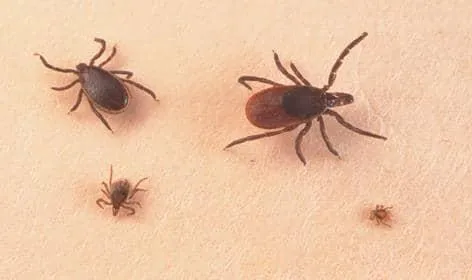Thank You
Thank you for your visit and for engaging with our services. Your support means the world to us! If you have any questions or would like to connect further, don't hesitate to reach out. We appreciate your time and look forward to sharing more valuable information with you in the future.
Blog
Blog

Ticks
Tick Season
Ticks are blood-sucking parasites commonly found throughout Canada. Peak tick season for nymphs usually occurs during the spring and summer months, while adults are a threat in the late fall. The pests are usually found in wooded areas that provide ample shade or in areas overgrown with tall grasses. Certain species of ticks are known to transmit harmful diseases, including Lyme disease, to both humans and domesticated animals.
Ticks | Facts & Identification, Control & Prevention (orkincanada.ca)
Problems Caused by Ticks
Ticks are important transmitters [sic] of disease; they carry bacteria and viruses known to cause serious illness in both humans and animals. American dog ticks are known carriers for such diseases as Rocky Mountain spotted fever and tularemia. Tularemia acts as a severely infectious bacterial condition characterized by fever, weight loss, and ulcers at the site of the infection. In severe cases, the disease may prove fatal. Some of the more common diseases transmitted [sic] by ticks include Lyme disease, which causes fatigue and may also lead to extreme problems with the central nervous system. Both animal and human hosts remain prone to tick paralysis, which may result in the loss of muscle function, most commonly associated with the reaction a person or animal may have to a neurotoxin produced in the salivary gland of the tick.
Ticks | Facts & Identification, Control & Prevention (orkincanada.ca)
Preventive and Precautionary Measures
Ticks need access to skin in order to effectively bite and latch on to a host. When hiking or walking through areas that are likely to be infested with ticks, individuals should wear long-sleeve shirts and pull their socks over their pant legs to keep the pests off. Residents should also avoid wearing open-toed shoes, such as sandals or flip flops, when spending prolonged time outdoors during tick season. Do a full-body check before re-entering the home to ensure no ticks have attached to your body or pets.
Ticks | Facts & Identification, Control & Prevention (orkincanada.ca)
Tick Bite Symptoms
Tick bite symptoms vary on a case-by-case basis. The exact symptoms depend on the species of tick and the severity of the allergic reaction to the bite. Tick bites frequently produce blisters or rashes on the skin of the victim. A distinctive red spot commonly develops at the site of the bite, as well. Other common symptoms of tick bites include uncoordinated movement and general weakness. The bites of certain tick species can also generate severe pain or swelling. In serious cases which demand immediate medical attention, tick bites may cause the victim to develop chest pain or heart palpitations, laboured breathing, a severe headache, or even paralysis. Medical attention should also be sought for the development of a fever, stiff neck, joint pain or muscle aches, sensitivity to light, swollen lymph nodes, or flu-like symptoms, as these indicators may signal the incubation of a tick-borne disease.
The risk of contracting disease from a tick bite remains high in areas known to support large populations of ticks. In fact, researchers contend that ticks spread more diseases than any other type of arthropod. Ticks spread disease by serving as vectors for bacterial, protozoan, and viral pathogens, which the biting ectoparasites transmit from one host to another. Canadians are increasingly exposed to the dangers of ticks as the parasitic pests become more prevalent across the country. Ticks in Canada transmit Lyme disease more commonly than other.
Ticks | Facts & Identification, Control & Prevention (orkincanada.ca)
Lyme Disease Symptoms
Early symptoms of Lyme disease are flu-like. Infected individuals may experience fever, chills, sweats, muscle aches, fatigue, nausea, and joint pain. Some more serious symptoms include numbness, swollen lymph nodes, muscle spasms, abnormal heartbeats, and cognitive dysfunction. Though cases can vary from person to person, the average individual starts experiencing symptoms within a few days. If left untreated for too long, the disease can cause permanent damage. Extreme cases may result in death.
Ticks | Facts & Identification, Control & Prevention (orkincanada.ca)
Habitat
Most species of ticks found throughout Canada typically occupy diverse habitats, ranging from densely wooded areas and forests to grasslands. However, the Rocky Mountain tick usually lives at higher elevations and prefers areas of brush in the foothills and mountain regions. Each species finds hosts in different ways, though all ticks are parasitic and need a host to survive. For instance, the American dog tick remains solitary by nature, moving from host to host between each developmental stage. The arthropod performs an act called questing in order to find new host animals. Climbing to the top of a blade of grass, the tick waits for a passing mammal and grasps on with a free pair of legs. Deer ticks utilize ambush techniques and wait for hosts to brush up against the object on which they are resting. Finally, the Rocky Mountain wood tick experiences stimuli from the environment, such as changes in humidity, temperature, and carbon dioxide levels, which typically represent the presence of a host.
Ticks | Facts & Identification, Control & Prevention (orkincanada.ca)
Diet
Ticks feed exclusively on the blood of a variety of different animals, from warm-blooded creatures like mammals and birds to such cold-blooded animals as lizards. Ticks typically take a single blood meal at each stage of the life cycle. After engorging on the blood of the host, the tick will usually fall off and find shelter somewhere until the need to take another meal becomes imperative and the process starts all over again. However, most ticks may be able to live for long periods of time between feedings if necessary. Adult ticks generally need larger hosts such as dogs, rabbits, raccoons, mice, squirrels, and human beings.
Ticks | Facts & Identification, Control & Prevention (orkincanada.ca)
First Aid
Check your dog regularly for ticks. It is important to remove them properly. Never burn, use chemicals, or try to squeeze them off the animal.
Here are the steps to remove a tick as according to Heather Davis, Canine Health and Emergency First Aid, 2022:
Invert a small container of rubbing alcohol over the tick. This will kill it.
Use proper tweezers or a tick removal tool to gently twist the mouthpiece and detach the tick. Ensure the tick is removed, otherwise parts of it may remain in your dog and could cause serious infection.
Put the removed tick into a container and have your veterinarian confirm it was a tick and that it is intact.
Types of Ticks
Hard Ticks
Hard ticks (Ixodidae) begin as an egg that is laid by an adult female tick. Once the egg hatches a larva emerges that must then find and feed on a small mammal or bird (host). After feeding it drops to the ground from the host and goes through a molting process, emerging as a nymph.
Nymphal hard ticks then seek larger hosts, and after feeding drop off and molt into adults. The life cycle of hard ticks lasts one to two years depending on the species. The bite of a hard tick is generally painless, with a feeding process lasting several hours, to days, even weeks.
There are 700 species of hard ticks.
Types of Ticks (with pictures of ticks) | Lymedisease.org
Soft Ticks
Soft ticks (Argasidae), like hard ticks begin as an egg, hatch into a larva, feed and then molt into a nymph. Nymphal soft ticks may go through as many as seven phases as nymphs, requiring a blood meal at each stage.
Soft ticks’ life cycle lasts from months to years depending on the species. The bite is typically painless and only lasts 15-30 minutes, making it harder to detect.
While both hard and soft adult ticks are easiest to identify, it is important to note that nymphal ticks are equally capable of transmitting disease. In some areas the nymphal tick infection rate is actually higher than the adult tick infection rate.
There are 200 species of soft ticks.

THE BEAST BOUTIQUE
Monday to Saturday: 6am-6pm
FAQS
What does pet insurance cover?
Our pet insurance plans are designed to cover a wide range of situations to keep your furry friend healthy and happy. This includes accidents, illnesses, surgeries, diagnostic tests, hospitalization, prescription medications, and even preventive care like vaccinations and annual check-ups. We're here to provide comprehensive coverage for your pet's well-being.
Are there breed or age restrictions for coverage?
No, we believe that every pet deserves access to quality healthcare. That's why we have no breed or age restrictions on our coverage. Whether your pet is a playful puppy or a wise old companion, our insurance plans are open to all breeds and ages. We're here to protect pets of all kinds.
How do I file a claim, and what's the process like?
Filing a claim with us is straightforward and hassle-free. When your pet receives treatment, simply collect the necessary invoices and medical records. You can then submit your claim online through our user-friendly portal. Our dedicated claims team will review your submission promptly. We strive to process claims quickly so you can get reimbursed for eligible expenses. We're here to guide you through the process and make it as simple as possible, ensuring your pet gets the care they need.


